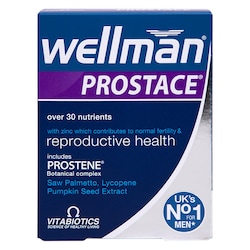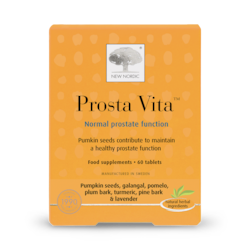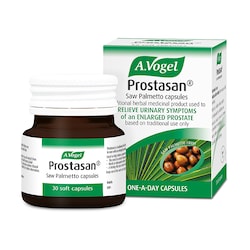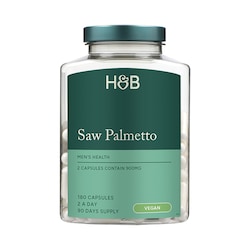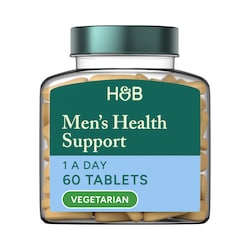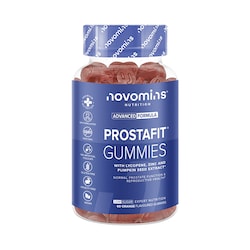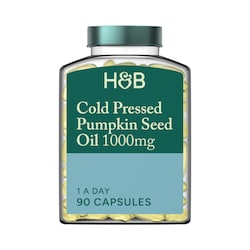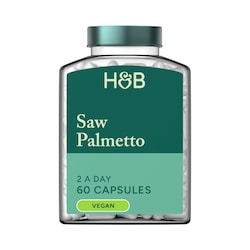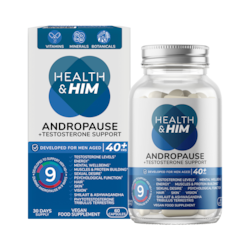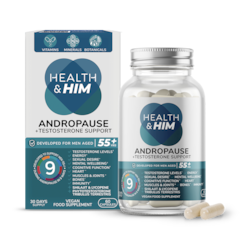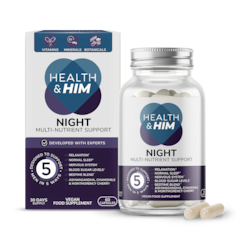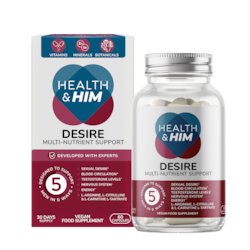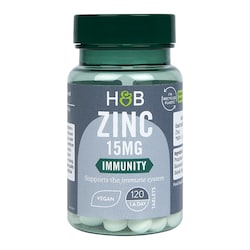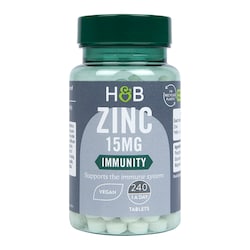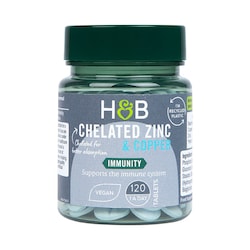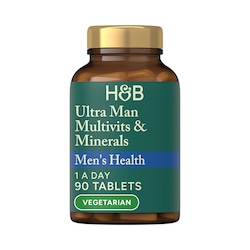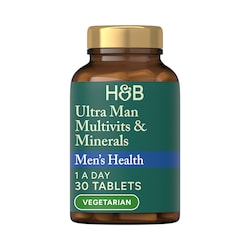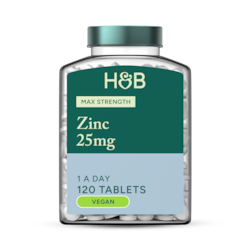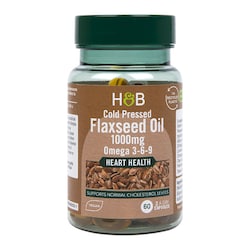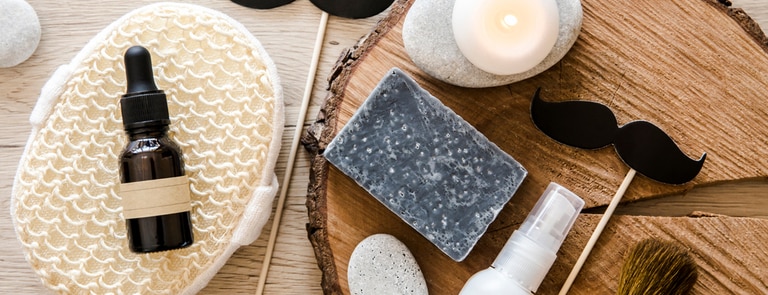15% off £20
Code:OFFER
How to support your prostate health

More than a third of men over 50 experience symptoms of prostate problems, but making simple changes to your lifestyle can help support your prostate health now and into the future
Summary
1Eating for prostate health
Research highlights the importance of a healthy, balanced diet is key for your prostate health...
2Exercise and your prostate
Regular exercise is essential for prostate health as it reduces stress, improves blood flow and helps you maintain a healthy weight...
3Get checked
Make sure you’re attending regular check-ups and tell your doctor about any symptoms you might be experiencing...
The prostate is a tiny gland that has a big impact. Found only in men and women who were assigned male at birth, as it produces semen and urinary function as well as other areas of your health.1,2
As you age, prostate issues can become more common and can include symptoms like needing to urinate more frequently or struggling to stop.1 But, some recent studies are shining a light on the connection between your lifestyle and prostate health.3
From eating more fruits and vegetables to getting your steps in and going for check-ups, we’ll explore some of the ways you can potentially support your prostate health.
Please note it's essential to consult your doctor if you're experiencing any of these symptoms – regular check-ups are the best way to manage your prostate health effectively.
What to eat for a healthier prostate
The link between diet and prostate health is an ongoing focus for research teams worldwide, so the current evidence available is limited. Overall, researchers have highlighted the benefits of a varied diet that is low in saturated fat and sugar, whilst high in fibre as the most beneficial for overall health, including prostate health.3,4
In addition, a small number of studies have focused on whether certain foods could be more effective at supporting your prostate health than others. From the humble tomato to a cup of green tea, here are three different foods that researchers are currently exploring in prostate health:
Tomatoes
Tomatoes are a fantastic addition to a healthy diet and contain a powerful antioxidant called lycopene – in fact, it’s lycopene that gives most tomatoes their striking red colour.5,6 As an antioxidant, lycopene works hard to neutralise free radicals (unstable molecules which can damage cells and tissues) and is thought to have potentially beneficial effects on keeping your prostate healthy.7,8,9
Your body absorbs lycopene much more easily once it’s been cooked – even more so, when cooked with a little olive or coconut oil.10 So, why not try making your own pasta sauce or roasting some tomatoes to go in a salad?

Cruciferous vegetables
In some studies, researchers found that those who ate more cruciferous vegetables had a lower risk of prostate cancer than those who ate less.11,12 However, in other studies, it was made clear that more studies and human trials were needed to assess whether cruciferous vegetables specifically can actually affect prostate health.13,14
Green tea
Green tea is rich in a type of polyphenol called catechin, particularly epigallocatechin-3-gallate (EGCG), which some believe, could play a role in the development of BPH.
In one small study, men with lower urinary tract symptoms given a blend of green and black tea every day for 12 weeks were better able to empty their bladder, had less inflammation and a better quality of life by the end of the study.16
Although more research is needed to confirm any benefits of green tea for prostate health, green tea is a delicious hot drink that can easily be enjoyed as part of a balanced diet.
What not to eat: foods that might affect your prostate
There's currently not a lot of strong evidence to pinpoint which foods are definitively harmful for your prostate, so more reliable studies are needed. However, of the research available, it’s highlighted that diets high in alcohol and some ultra processed foods which contain high levels of salt or sugar, may result in prostate conditions:
Alcohol
Drinking too much alcohol has long been shown to have a negative effect on your health. In fact, after 10-20 years of regular drinking, the NHS believes you’re more at risk of developing problems with your heart, liver and some types of cancer.17
The link between alcohol and the risk of prostate problems, particularly prostate cancer, is a long-debated topic. Whilst many studies suggest that drinking alcohol can increase the risk, others can’t confirm that a correlation exists at all.18
However, alcohol is a diuretic, so when you drink it, you might find you need to urinate more often.19 There is some research to suggest that this can irritate the bladder and make symptoms of prostate conditions, like BPH, worse.20,21
For your overall health, it’s best to limit your alcohol intake and stick within the recommended weekly alcohol units. The NHS recommends that men and women drink no more than 14 units of alcohol a week on a regular basis – 14 units is roughly the equivalent of 10 small glasses of lower-strength wine or six pints of average strength beer.22
Too much red or processed meat
The World Health Organisation suggests that a diet high in red meat and processed meats might be associated with the increased risk of developing prostate issues, especially prostate cancer.23
This is due to the way in which meat is processed or cooked. Meat processing like curing (where nitrates are added) or smoking, can lead to the formation of carcinogenic chemicals which can cause illnesses.24 The same can be said for meats which are cooked over a flame, like grilling or barbecuing.24
Red meat is a good source of protein, iron, zinc and B vitamins.24 So, instead of cutting it out completely, try limiting your intake instead – the NHS recommends around 70g of red or processed meat per day.24
Processed foods

Ultra-processed foods, like fast food, can be loaded with unhealthy fats, salt, refined carbohydrates and added sugars, which aren’t great for your health when consumed in large quantities.25
However, it's important to remember that not all processed foods are unhealthy. Some processed foods, such as canned beans or frozen vegetables, can be part of a healthy diet as processing can also help make foods safe, add additional nutrients or help them last longer.26
Is there a link between exercise and the prostate?
Exercising regularly is important for your overall physical health, and there’s growing research that exercise is especially important for your prostate health too. In fact, some research showed that men who exercised regularly were less likely to experience prostate problems than those who didn’t.26
Whilst the specifics of how exercise affects the prostate gland are still up for debate, researchers believe regular exercise contributes to a healthy prostate by:
- helping with weight management: being overweight is linked to an increased risk of prostate problems27,28
- improving blood flow: exercising regularly helps to promote better blood circulation, ensuring adequate blood flow to the prostate which helps deliver essential nutrients and oxygen to the prostate gland
- reducing stress: stress can disrupt hormonal balance, which can impact prostate health and possibly cause prostate issues like prostatitis29
Three easy exercise tips for a healthier prostate
- aim for at least 20 minutes a day: the NHS recommends 150 minutes of moderate to intense activity a week, which is about 20 minutes a day.30 Whether it’s getting your daily steps in, taking part in an exercise class or lifting weights, any exercise that raises your heart rate and makes you breathe faster counts
- try Kegel exercises: these exercises specifically focus on strengthening your pelvic floor muscles and can help with urinary problems31
- start slowly: if you’re not currently active, start with short periods of exercise and gradually increase your time. Start by making small changes where you can – like taking the stairs or parking your car slightly further away from where you need to go
When to see your doctor about your prostate
If you’re experiencing symptoms like frequently urinating, difficulty urinating, blood in your urine or pain when urinating, it’s important that you consult your doctor.1
The best way to stay on top of your prostate health is to make sure you’re attending regular check-ups and communicating any symptoms with your doctor.1 You should also let your doctor know if there are prostate problems in your family history.
Going for your check-ups and talking openly to your doctor can help detect any possible problems early and result in more effective management.1
The final say
Your prostate gland might be small, but its health matters. We know it’s not realistic to change your diet and lifestyle overnight, but making small changes can have a big impact in your overall health – including that of your prostate.
By exercising regularly, limiting heavily processed foods high in salt and sugar and fuelling your body with a diet rich in fruits, vegetables, lean proteins, and whole grains, you can support your prostate health and overall well-being. In addition, make sure to attend your regular check-ups and tell your doctor about any possible symptoms for effective management.
This article provides informational advice and is not a substitute for medical care. Curated by experts for accuracy, we take great care to ensure the information is up-to-date and relevant. However, you should always consult your GP or healthcare professional before using supplements or alternative products, particularly if you have medical conditions or are under supervision.
1. NHS Choices. Prostate problems [Internet]. 2024 [cited 2024 Oct 30]. Available from: https://www.nhs.uk/conditions/prostate-problems/
2. NCI Dictionary of Cancer Terms [Internet]. Cancer.gov. 2024 [cited 2024 Dec 2]. Available from: https://www.cancer.gov/publications/dictionaries/cancer-terms/def/prostate
3. Matsushita M, Fujita K, Norio Nonomura. Influence of Diet and Nutrition on Prostate Cancer. International Journal of Molecular Sciences [Internet]. 2020 Feb 20 [cited 2024 Oct 30];21(4):1447–7. Available from: https://pmc.ncbi.nlm.nih.gov/articles/PMC7073095/
4. Health U. Nutrition and Prostate Cancer [Internet]. ucsfhealth.org. UCSF Health; 2024 [cited 2025 Jan 7]. Available from: https://www.ucsfhealth.org/education/nutrition-and-prostate-cancer
5. Duma M, Alsina I, Dubova L, Erdberga I. Chemical composition of tomatoes depending on the stage of ripening. Chemical Technology. 2015 Oct 27;66(1). Available from: https://www.researchgate.net/publication/283776075_Chemical_composition_of_tomatoes_depending_on_the_stage_of_ripening
6. Petruzzello M. Why Are Tomatoes Red? [Internet]. Encyclopedia Britannica. 2024 [cited 2024 Oct 30]. Available from: https://www.britannica.com/story/why-are-tomatoes-red
7. Rh H, Elbakbak W, Bouhelal A, Müller S. Oncology and Cancer Case Reports Does Oral Lycopene Reduce Benign Prostate Enlargement/Hyperplasia (BPE/BPH)? Oncol Cancer Case Rep [Internet]. 2016;2:1. Available from: https://www.iomcworld.org/open-access/does-oral-lycopene-reduce-benign-prostate-enlargementhyperplasiabpebph-occrs-1000108.pdf
8. Wei MY, Giovannucci EL. Lycopene, Tomato Products, and Prostate Cancer Incidence: A Review and Reassessment in the PSA Screening Era. Journal of Oncology [Internet]. 2012 Jan 1 [cited 2024 Oct 30];2012:1–7. Available from: https://pmc.ncbi.nlm.nih.gov/articles/PMC3368367/
9. Chen P, Zhang W, Wang X, Zhao K, Negi DS, Zhuo L, et al. Lycopene and Risk of Prostate Cancer. Medicine [Internet]. 2015 Aug [cited 2024 Oct 30];94(33):e1260. Available from: https://pmc.ncbi.nlm.nih.gov/articles/PMC4616444/
10. Arballo J, Amengual J, Erdman JW. Lycopene: A Critical Review of Digestion, Absorption, Metabolism, and Excretion. Antioxidants [Internet]. 2021 Feb 25 [cited 2024 Oct 30];10(3):342–2. Available from: https://pmc.ncbi.nlm.nih.gov/articles/PMC7996133/
11. Long J, Liu Z, Liang S, Chen B. Cruciferous Vegetable Intake and Risk of Prostate Cancer: A Systematic Review and Meta-Analysis. Urologia Internationalis [Internet]. 2023 Jan 1 [cited 2024 Oct 30];107(7):723–33. Available from: https://pubmed.ncbi.nlm.nih.gov/37343525/
12. Ferreira PMP, Rodrigues LARL, Paula, Paulo, Michel L, Nunes NMF, et al. Cruciferous Vegetables as Antioxidative, Chemopreventive and Antineoplasic Functional Foods: Preclinical and Clinical Evidences of Sulforaphane Against Prostate Cancers. Current Pharmaceutical Design [Internet]. 2019 Jan 18 [cited 2024 Oct 30];24(40):4779–93. Available from: https://pubmed.ncbi.nlm.nih.gov/30652644/
13. Ballon-Landa E, Parsons JK. Nutrition, physical activity, and lifestyle factors in prostate cancer prevention. Current Opinion in Urology [Internet]. 2017 Oct 18 [cited 2024 Oct 30];28(1):55–61. Available from: https://pubmed.ncbi.nlm.nih.gov/29049045/
14. Zuniga KB, Chan JM, Ryan CJ, Kenfield SA. Diet and lifestyle considerations for patients with prostate cancer. Urologic Oncology Seminars and Original Investigations [Internet]. 2019 Jul 18 [cited 2024 Oct 30];38(3):105–17. Available from: https://pubmed.ncbi.nlm.nih.gov/31327752/
15. Nutritional benefits of cruciferous vegetables • HRI [Internet]. Heart Research Institute. 2021 [cited 2024 Oct 30]. Available from: https://www.hri.org.au/health/your-health/nutrition/nutritional-benefits-of-cruciferous-vegetables
16. Burcu Erbaykent Tepedelen, Soya E, Korkmaz M. Epigallocatechin-3-gallate reduces the proliferation of benign prostatic hyperplasia cells via regulation of focal adhesions. Life Sciences [Internet]. 2017 Oct 12 [cited 2024 Oct 30];191:74–81. Available from: https://pubmed.ncbi.nlm.nih.gov/29032114/
17. Katz A, Efros M, Kaminetsky J, Herrlinger K, Chirouzes D, Ceddia M. A green and black tea extract benefits urological health in men with lower urinary tract symptoms. Therapeutic Advances in Urology [Internet]. 2014 Mar 20 [cited 2024 Oct 30];6(3):89–96. Available from: https://pmc.ncbi.nlm.nih.gov/articles/PMC4003843/
18. NHS England. The risks of drinking too much [Internet]. nhs.uk. 2022 [cited 2025 Jan 7]. Available from: https://www.nhs.uk/live-well/alcohol-advice/the-risks-of-drinking-too-much/
19. Macke AJ, Petrosyan A. Alcohol and Prostate Cancer: Time to Draw Conclusions. Biomolecules [Internet]. 2022 Feb 28 [cited 2025 Jan 7];12(3):375–5. Available from: https://pmc.ncbi.nlm.nih.gov/articles/PMC8945566/
20. Palmer E, Tyacke R, Sastre M, Lingford-Hughes A, Nutt D, Ward RJ. Alcohol Hangover: Underlying Biochemical, Inflammatory and Neurochemical Mechanisms. Alcohol and Alcoholism [Internet]. 2019 Feb 6 [cited 2025 Jan 7];54(3):196–203. Available from: https://academic.oup.com/alcalc/article-abstract/54/3/196/5420612?redirectedFrom=fulltext
21. Calogero AE, Burgio G, Condorelli RA, Cannarella R, Sandro La Vignera. Epidemiology and risk factors of lower urinary tract symptoms/benign prostatic hyperplasia and erectile dysfunction. The Aging Male [Internet]. 2018 Feb 2 [cited 2025 Jan 7];22(1):12–9. Available from: https://pubmed.ncbi.nlm.nih.gov/29392976/
22. Langan RC. Men’s Health: Benign Prostatic Hyperplasia. FP essentials [Internet]. 2021 [cited 2025 Jan 7];503. Available from: https://pubmed.ncbi.nlm.nih.gov/33856179/
23. World Health Organisation [Internet]. 2015 [cited 2025 Jan 7]. Available from: https://www.who.int/news-room/questions-and-answers/item/cancer-carcinogenicity-of-the-consumption-of-red-meat-and-processed-meat
24. NHS website. Meat in your diet [Internet]. nhs.uk. 2022 [cited 2025 Jan 7]. Available from: https://www.nhs.uk/live-well/eat-well/food-types/meat-nutrition/
25. NHS website. Processed foods [Internet]. nhs.uk. 2022 [cited 2025 Jan 7]. Available from: https://www.nhs.uk/live-well/eat-well/how-to-eat-a-balanced-diet/what-are-processed-foods/
26. Health Professionals Follow-Up Study | Harvard T.H. Chan School of Public Health [Internet]. Harvard T.H. Chan School of Public Health. HSPH; 2024 [cited 2025 Jan 6]. Available from: https://hsph.harvard.edu/research/health-professionals/
27. Physical activity, weight and prostate cancer [Internet]. Cancerresearchuk.org. 2024 [cited 2025 Jan 7]. Available from: https://www.cancerresearchuk.org/about-cancer/prostate-cancer/practical-emotional-support/physical-activity
28. Dickerman BA, Ahearn TU, Giovannucci E, Stampfer MJ, Nguyen PL, Mucci LA, et al. Weight change, obesity and risk of prostate cancer progression among men with clinically localized prostate cancer. International Journal of Cancer [Internet]. 2017 Jun 8 [cited 2025 Jan 7];141(5):933–44. Available from: https://pmc.ncbi.nlm.nih.gov/articles/PMC5518616/
29. Prostatitis: Inflammation of the Prostate [Internet]. National Institute of Diabetes and Digestive and Kidney Diseases. NIDDK - National Institute of Diabetes and Digestive and Kidney Diseases; 2025 [cited 2025 Jan 7]. Available from: https://www.niddk.nih.gov/health-information/urologic-diseases/prostate-problems/prostatitis-inflammation-prostate
30. NHS website. How to be more active - Better Health [Internet]. nhs.uk. 2023 [cited 2025 Jan 7]. Available from: https://www.nhs.uk/better-health/get-active/how-to-be-more-active/
31. Pelvic floor muscle exercises [Internet]. Prostate Cancer UK. 2021 [cited 2025 Jan 7]. Available from: https://prostatecanceruk.org/prostate-information-and-support/living-with-prostate-cancer/pelvic-floor-muscle-exercises



